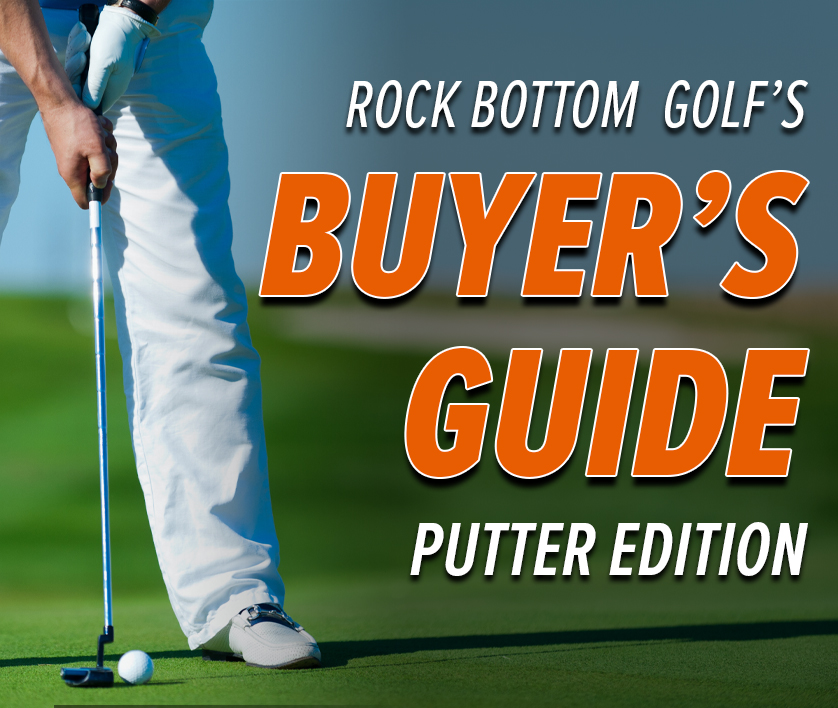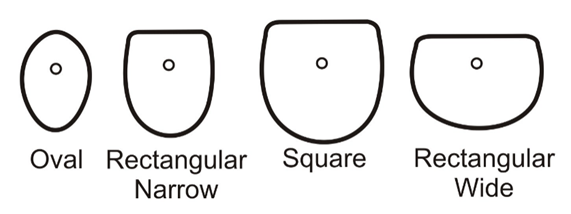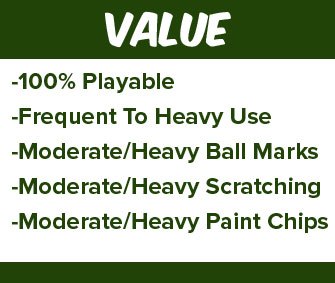

Table Of Contents: Golf Putter Buyer's Guide
The Golf Putter
One of the most important clubs in your bag is your golf putter. Barring an unlikely hole-in-one or an almost impossible shot from outside the green, your putter is the final club a golfer uses on just about every shot. Like all clubs, manufacturer innovations help to optimize performance. Regardless, choosing a putter comes down to personal preference. Here is a look at some options and styles of putters available to help you decide.
Putter Shafts And Putter Length

Using the correct shaft for your height can easily shave strokes off your score and be a total game-changer. After all, the putter is the last club you'll use on any given hole, and it should be the club you can confidently use to complete your final, winning stroke. So, how well you use it can directly impact your score.
Your height in proportion to the shaft length is a big part of the equation. The shaft length directly correlates to a player's height. Using the correct putter length for your height helps set up the proper putting posture and alignment. And you will sink many more putts when using the best posture and alignment to make a putt.
Aside from that, with the proper length putter, you can stand comfortably with your eyes directly over the ball, which improves your aim and overall accuracy. Using the correct putter length can also help reduce strain on your back and shoulders. And that can be a lifesaver after a full round of golf!
Using the Correct Putter Length
Most putters, or traditional length putters, are about 32 inches to 36 inches in length and are designed for a smooth, rhythmic swing. However, you can opt for a longer shaft ranging from 36 inches to 38 inches for more stability. Longer shafts are designed for golfers to reach further down on the shaft. And this puts more weight above the hands and allows for greater shot stability. But what you use comes down to your personal preference. However, putter length should still correlate to your height.
Here is a simple, straightforward test to ensure you are using the proper length. Get into your putting stance. Simply measuring the distance from the putting green to your wrists will determine the height you need. Accordingly, here is a breakdown of the different shaft lengths recommended for varying heights:
| Player Height | Shaft Length |
|---|---|
| Taller Than 6’4” | 36" |
| 6’2” - 6’4” | 35.5" |
| 6’0” - 6’2” | 35" |
| 5’8” - 6’0” | 34.5" |
| 5’6” - 5’8” | 34" |
| 5’4” - 5’6” | 33.5" |
| 5’2” - 5’4” | 33" |
| 5’0” - 5’2” | 32.5" |
| Under 5 feet | 32" |
Putter Hosel
Hosel selection is another choice when purchasing a golf putter. The hosel connects the shaft to the head of the club. While this may not seem significant, it can impact how you align the club and hit the ball. The most common types are heel-shafted and offset. An advantage of offset styles is they improve visibility when lining up the club to the ball. A less common design is center shafted. This design positions the golfer directly over the ball while holding the club.
Center Shafted
While less common, the center shaft does appeal to players with a straight style. This design positions the golfer directly over the ball while holding the club. And it is perfect when a golfer has no bias in their swing that causes the ball to arc or curve.
Heel Shafted / Offset
This type of hosel design is much more common. This configuration puts the shaft at the edge of the clubhead. It allows a golfer with more of an arc in their putting style to be more accurate. Another advantage of offset styles is to improve visibility when lining up the club for the ball.
Putter Grips
You cannot select a putter without at least addressing the role of the grip. This feature may not be as glamorous or as sought-after as other features, but it is still essential. When evaluating the grip, a rule of thumb is the importance of feel while you putt. A thicker grip will help to muffle the vibration. You will not have as much feedback when you swing the club, which could be disastrous for golfers with a lot of arc in their swing.

Along with the above putter grip considerations, the putter's grip type, shape, and thickness can affect putter performance in other ways. For example, thicker putter grips can make the putter "feel" lighter but may add weight to the club overall. There are also several standard grip shapes and styles to choose from (see image). The grip shape and style a golfer uses are up to the golfer's grip style and preference. So, taking time to determine what putter grip works best for you can help you sink more putts and lower your score.
Toe Or Face Balanced
The club's weighting is a design selection that can complement or detract from your game. Face-balanced putters have a center of gravity below the shaft. This configuration is better for a straight putter, where the backswing is less critical. In contrast, a toe-balanced putter is designed more for golfers with an arc-style putt.
Putter Head Types
The clubhead is probably the most distinguishable characteristic of a golf putter. It is also one of the easiest ways to quickly sort through the enormous selection of putters available to you. The two principal types are blade and mallet putters.

Blade Putters
Still the preferred choice of many professional golfers, the blade putter is perfect for faster greens. It is harder to align than a mallet putter but affords other benefits. The blade is much more suited to golfers with an arc-like stroke and offers more control, but it can be unforgiving for less experienced golfers.
Mallet Putters
Much larger than its traditional blade counterpart, the mallet putter offers several advantages to your golf game. A mallet putter can be easier to handle than a blade putter. It is also designed to line up the club with the ball easily. These types of putters also offer a lot of unique options. While your club choice is a personal preference, this putter is ideal if you have a straight back and straight through stroke, meaning no arc.

Lefties and Ladies Putters
As with all golf clubs, putters come in lefties and ladies' styles. The only real difference between right-handed and left-handed putters is the club's orientation and the grip.
Ladies' putters may be lighter with thinner grips. Other than that, ladies' putters may also come in different colors.
90-Day Putter Performance Guarantee
Plus, at RBG, you can rest assured that you have made the correct putter purchase with our 90-Day Performance Guarantee! Rock Bottom Golf prioritizes customer satisfaction. If you're unhappy, you can return a qualifying putter purchase for store credit. All qualified goods have a 90-Day Performance Guarantee icon.
Pre-Owned And Used Putters
Purchasing a pre-owned putter is a great way to get one for a lower price than brand new. However, there are a few things to consider when buying a pre-owned putter. For example, a pre-owned putter grip may not be the stock grip. Also, there may have been some other custom weighting on the club's sole or added to the head depending on the previous owner's playing style.
Rock Bottom Golf is a golf retailer with many years of expertise and a devoted staff of certified pre-owned club specialists. Those specialists evaluate each putter entering our warehouse and assign it to one of the pre-owned club condition rankings shown below. RBG even offers a 30-Day Pre-Owned Playability Guarantee on several of our used clubs, so you can be sure you're receiving the quality you expect when you buy.
Click on the pre-owned categories below to find out more!
Golf Putter Frequently Asked Questions
What types of putters are there?
Several types of putters are available, including blade putters, mallet putters, and more recent designs such as high MOI (moment of inertia) putters and center-shafted putters. Each type has unique characteristics and finding one that feels comfortable is essential.
What materials are putters made of?
Putters are traditionally made of metal materials like steel or stainless steel. However, putters can also be made from lightweight materials such as aluminum or carbon fiber. Some putters are made from exotic materials such as titanium, tungsten, or copper.
What is the difference between face-balanced and toe-balanced putters?
A face-balanced putter is built with the center of gravity squarely beneath the center of the putter's face. This makes aiming and maintaining a square face to the target easier. A toe-balanced putter, on the other hand, has the center of gravity closer to the putter's toe. Having more weight placed at the toe may make it more appropriate for players who have a somewhat arcing putting stroke.
What are the benefits of a counterbalanced putter?
Counterbalanced putters have more weight on the grip end of the putter. And this can help increase the stability and control of the putter, allowing for a smoother stroke. It can also help with distance control and accuracy by reducing hand and wrist movement.
What is the role of shaft length in putter selection?
The length of the putter shaft can play an essential role in your putting performance. A putter that is the correct length will allow you to maintain good posture and relax your arms while putting. A putter that is too long or short can cause you to hunch over or stand too tall, which can negatively impact your stroke. Try different lengths to see what feels most comfortable.
How do I care for my putter?
Clean the clubhead and grip of your putter after every round to keep it in good shape. You can clean the clubhead with mild soap and water and the grip with a damp cloth. Also, keep it in a dry place and not lean it against a wall or leave it in a car, where the heat and humidity can damage it.
Can a putter be adjusted?
Some putters can be adjusted for weight, lie, and loft. These putters often have removable weights or adjustable sole plates. If you're uncomfortable making these adjustments yourself, you should consult a club fitter or professional club builder. Also, remember that putters with adjustable features will likely be more expensive.
What is the difference between a blade and a mallet putter?
A blade putter is a traditional putter style with a narrow head. They are better for straighter, more controlled putters due to their lighter heads. Mallet putters have larger heads and rounded shapes. They're better for arcing putting strokes and off-center hits due to their heavier heads.
How do I choose the right putter length?
Your right putter length will depend on your height and stance. If you are taller, you may choose a slightly longer putter; if you are shorter, you may want to choose a slightly shorter one. Additionally, make sure your arm is straight when you address the ball. If they are bent, it's a sign that the putter is too short or too long.
What is the proper grip for a putter?
A "reverse overlap" grip is the proper grip for a putter. Overlap your left hand's pinkie finger on top of your right hand's index finger to create a more stable and consistent grip. You can also try a "cross-handed" grip, which involves placing your left hand low on the grip and your right hand high. This grip is typically used by golfers seeking a more relaxed and natural feel.
How do I align my putter correctly?
Start by aiming your putter at the target hole, and then check that the leading edge of your putter is parallel to the target line. These two steps will ensure your aim is true and your stroke is square to the target. You may also use alignment aids on top of your putter, such as lines or dots, to further assist with proper aim.
How can I improve my putting stroke?
To improve your putting stroke, keep your arms and hands relaxed and your wrists firm. Ensure your shoulders and hips are square to the target, and your eyes are directly over the ball. Keeping your head still and avoiding unnecessary movement during the stroke is also essential. Practicing drills and visual aids to check your alignment can help you improve your putting stroke over time.
The Main Takeaway?
Using the correct putter for your playing style can help lower your score significantly. However, just like any golf club, your choice of putter can hinder your game if it doesn't work for you or feel right in your hands while playing. Putting is all about feel and finding a club that works for you and your game. So, when buying a new putter, don't rush the process. Take the time to go through a handful of different putter setups to see what fits the best for you.
Popular Putters For 2025
Choosing the right putter is key to improving your game on the green. Rock Bottom Golf helps make this decision simple. If you're seeking more confidence and consistency, mallet putters provide greater stability and alignment support—ideal for beginners. Prefer enhanced precision and feedback? Blade putters deliver unmatched control and feel for golfers with a steady stroke.
Check out these putters recommended by our experts:
What Putters Do The Pros Use
Modern golf putters are meticulously engineered with cutting-edge technology, including innovative alignment aids for improved accuracy. Knowing that a Tour professional plays a specific putter can give you confidence and is a strong endorsement of its performance. With that in mind, here is a list of putters used by Tour players.
According To PGAClubTracker.com, here are the golf putters used by various PGA Tour Champions:
- Rory McIlroy: TaylorMade Spider Tour X3
- Tiger Woods: Titleist Scotty Cameron Newport 2 GSS Prototype
- Jon Rahm: Odyssey Ai-ONE Rossie S
- Dustin Johnson: TaylorMade Spider Tour T3.0
- Justin Thomas: Titleist Scotty Cameron Phantom 9.5 Tour Prototype
- Collin Morikawa: TaylorMade TP Soto
- Bryson DeChambeau: LA Golf SIK Pro C-Series Armlock Proto
- Brooks Koepka: Titleist Scotty Cameron T5.5
- Jordan Spieth: Titleist Scotty Cameron Circle T 009
- Scottie Scheffler: TaylorMade Spider Tour X






